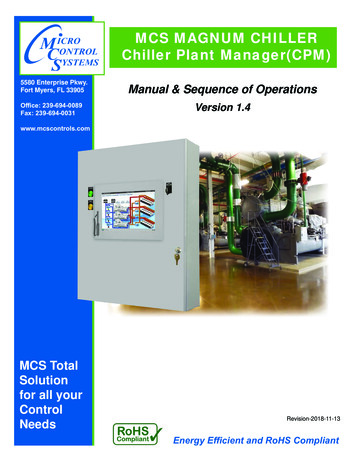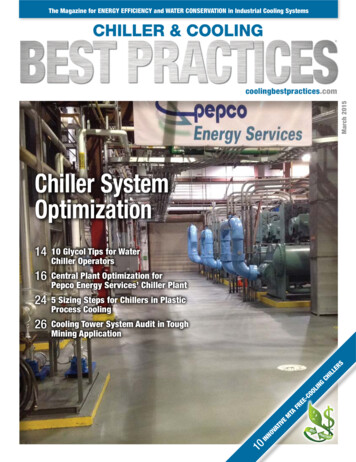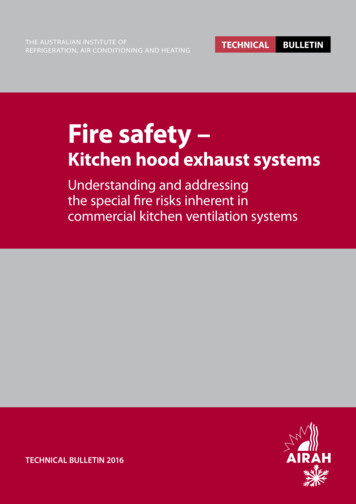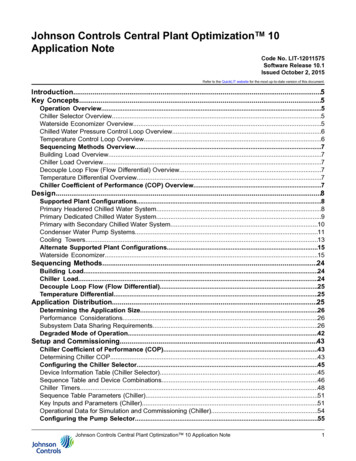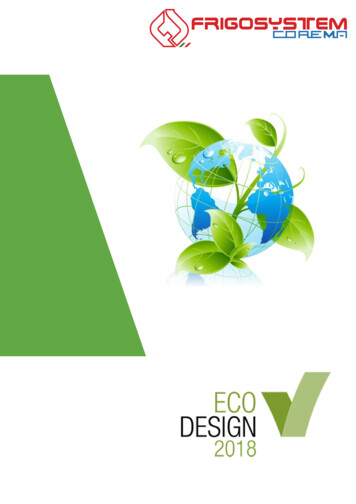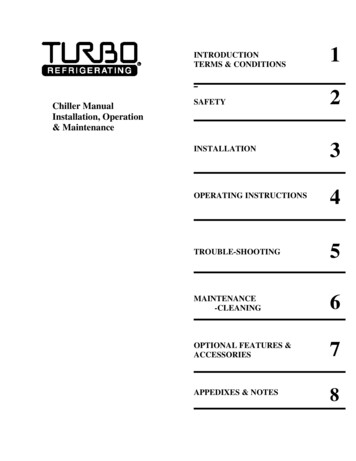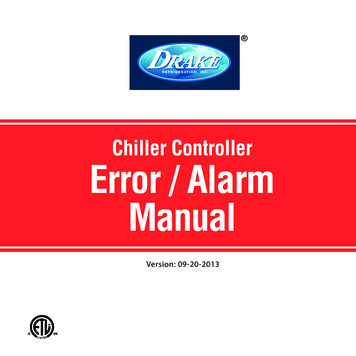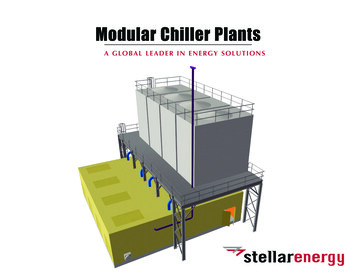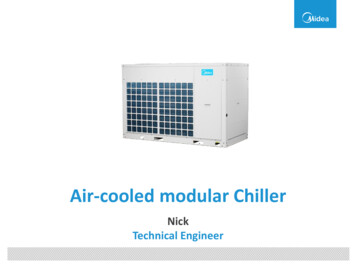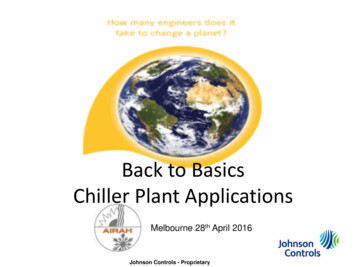
Transcription
Back to BasicsChiller Plant ApplicationsMelbourne 28th April 2016Johnson Controls - Proprietary
Many dancyEnergyIndoor spaceComfortWaterNoiseOutdoor spaceMarketing2Johnson Controls - ProprietaryCodes/Standards
Chiller Plant Operating Costs Consumables Water Maintenance ENERGYEnergy Cost of Plant LoadXHoursXEfficiencyXHolistic Chiller Plant Approach3Johnson Controls - ProprietaryRateStructure
Automation is a key component of the optimization processbut optimization is not just smart controlsMaintainMeasure & VerifyOperating DecisionsOptimize SystemAutomate SystemApply components effectively, optimallyDesignDecisionsSelect components effectively, optimallyDesign system infrastructure to max efficiency potentialJohnson Controls - Proprietary
Design Energy Vs. Annual wer5%Pumps22%Design PerformanceAnnual Energy UsageFlexibilityEfficiencySustainabilityLife CycleJohnson Controls - Proprietary & ConfidentialTower2%
Air cooled vs Water cooledHeat rejection mediumAirWaterPerformancedry bulb basedwet bulb basedFull Load EfficiencyLowerHigherPart load efficiencyLower#HigherChiller SizelargerbaselineWater usageNO*YESLocationOutdoorsIndoors (plant-room)InstallationLess complexMore complexMaintenanceLess complexMore complex# Plant efficiencies are dependent on climate, control, and other factors* Power generating stations use water to produce electricityJohnson Controls - Proprietary
VSD technology unlocks efficiency benefit of natural weather conditionsConstantYKCSD AHRISpeed,ReliefAHRI ReliefConstantSpeed,YK CSD ConstantCEFTConstant CEFT14.0VariableSpeed,YK VSD AHRIReliefAHRI Relief13.0VariableSpeed,YMC2 AHRIReliefAHRI Relief oil-freeChillers operatefor 85% of thetime within thiscapacity 7080% CapacityNote: Above is based on water cooled centrifugal compressor technologyJohnson Controls - Proprietary90100
The design process Minimize ‘transport’ energy Maximize the economics of highefficiency components Optimize ‘lift’Johnson Controls - Proprietary
Pressure- enthalpy diagrampressure6 5condenser4Metering device13compressorevaporatorenthalpyJohnson Controls - Proprietary2
Water cooled chillersStandard design lift conditionPressure35 C29.4 CLift orDifferentialPressure12.2 C6.7 CEnthalpyJohnson Controls - Proprietary
ASHRAE Handbook (2008): What is Heat Recovery?“In many large buildings, internal heat gains require year-round chilleroperation. The chiller condenser water heat is often wasted through a coolingtower” “[Heat recovery] uses otherwise wasted heat to provide heat at thehigher temperatures required for space heating, reheat, and domestic waterheating”Heat recovery creates and uses energy at higher chiller lift conditionto improve overall building efficiency11Johnson Controls - Proprietary
What is Heat Recovery?Building withEnergy RecoveryCooling Tower(40ºC)(35ºC)CondenserHeat RecoveryMotorExpansion ValveCompressorEvaporatorExample – reheat cooled and de-humidifiedO/A to neutral condition for use with a passivechilled beam system with site recovered energy(12.2ºC)(6.7ºC)Boiler12Johnson Controls - Proprietary
Why use a heat recovery chiller?Economic Advantages Operational savingsSocial / Environmental Advantages CO2 reductions Reduced water consumptionCoincident heating and coolingCooling capacity 680 kWrHeat rejection 820 kWrPower input140 kWeTotal COP 1500 / 140 10.713Johnson Controls - Proprietary
What is lift relief ?Lower tower water tempsAND / ORHigher chilled water temps14Less compressor work lower input kWeJohnson Controls - Proprietary
Reduce liftCapitalizing on ‘off-design’ conditions -most of the timeLowering Condenser WaterTemperaturePressureLowers the LiftCondenserLiftCompressorExpansionReduces Compressor WorkEvaporatorEnthalpyJohnson Controls - ProprietaryReducesEnergyConsumption
Reduce liftCapitalizing on ‘off-design’ conditions -most of the timeRaising Chilled rs the LiftCompressorEvaporatorEnthalpyJohnson Controls - ProprietaryReduces Compressor WorkReducesEnergyConsumption
How does lower LIFT (compression ratio) impact efficiency ?Variable Speed Chiller Energy Usage Analogy Condenser Temp.100%29.40 C ECWT12.8 C ECWTLoad(weight ofrock)0%Off- Design LiftENERGY50%Evaporator Temp.44 F (6.7 C) LCHWTJohnson Controls - Proprietary
18Johnson Controls - Proprietary
Legionella growth is dormant below 20CYork chillers can operate at low condenserwater temperaturesCold tower water assists to control Legionella growth19Johnson Controls - Proprietary
Water Consumption is afunction of TOTAL HEATREJECTION.HEAT REJECTION Cooling Capacity Shaft Power Condenser Pump PowerThus, Lower Shaft Power Lower Water Consumption!20Johnson Controls - Proprietary
Benefits of Cold Cond. Water on High TempChiller (i.e. 14C leaving evap. YMC2)21Johnson Controls - Proprietary
Opportunities for Lower LiftLower Condenser WaterTemperature Lower CW Design Temperatures Oversize Towers Climate wet bulb relief Control Strategy Chiller / Tower optimization Series Counter-flowHigher Chilled Water Temperature Higher CHW Design temperatures Climate wet bulb relief Control strategy chilled water reset Series & Series Counter-flow Multiple CHW loops HT loop & LT loop22Johnson Controls - Proprietary
Series chillers6 deg C10 deg C14 deg CLift is reduced 4 degrees CJohnson Controls - Proprietary
Enhanced efficiency through series counter-flowPressurePressureCondenserCondenser 2CompressorLift 1Compressor 1Evaporator 1EvaporatorEnthalpyEnthalpyECHWTCompressor 2Condenser 1Evaporator 2Lift 2140 C100 CEvaporator60 CEvaporatorLCHWTECWTLCWT350 CCondenserCondenser320 CJohnson Controls - Proprietary290 C
Enhancedefficiencythroughseriescounter-flowTotal Capacity (kWr)Evap Flow Total (L/s)Evap DP (kPa)Cond Flow Total (L/s)Cond DP (kPa)R134a Charge (kg)Cost ( )VPF Evap min (L/s)Parallel ChillersSCF Chillers2 x 15002 x 150044.7 x 2 89.489.482.478.969.8 x 2 139.6138.776.954.22 x 603 1206 2 x 438 876BASELess than BASE1322Load (kWr)30002700Parallel (kWe)471.0378.0SCF 312.7%14.1%12.7%30075.466.09.312.4%Johnson Controls - ProprietarySaving (kWe)%24.55.2%22.56.0%
Today’s and tomorrow’s challengeAdditional component-level efficiency gains will be insufficient.1".we are reaching maximum technological limits at a componentlevel and that in the future the industry will have to look at thefull HVAC system for further improvements. AHRI is in the processof forming a new working group to address systems approaches forefficiency improvements and will work closely with Standard 90.1.”- Dick Lord, co-writer of addendum ‘ch’ to ANSI/ASHRAE/IESStandard 90.1-2010, ASHRAE Press Release, December 12, 2012Johnson Controls - Proprietary
Primary / Secondary SystemPrimary/Secondary System Know the benefits and limitationsof the system type P/S System: Recommend to SizePrimary Pumps for more flowthan Secondary Pumps VPF System: Pump Head ofLow Load ChillerVSD & VPF System27
VSD & VPF SystemVariable Chilled Water Flow28
The role of controls in the optimization processBest-in-class algorithms that take a holistic, system-level approachAll variable speed plantJohnson Controls - Proprietary
Johnson Controls - Proprietary
Most Energy Efficient Chiller Plant Design 6.7 Plant COPJEM is identified as the “Greenest Building” in Singapore (2013)Johnson Controls - Proprietary
System efficiency targets Singapore Green Mark v4Platinum rating @ 0.55kW/Ton 6.4 plant COPTraditional chiller plantCOPJEM Project delivering 0.527 kW/TR system efficiency:Low temp loop 9/18 deg C with 2 x YORK YK series counter-flow CSD chiller pairsHigh temp loop 15/20 deg C with 2 x YORK YK VSD chillersJohnson Controls - Proprietary
Efficient System Design Concepts applied to HVAC system AHU(s)DOASHT CHW loopLT CHW loop15 C9CVPF13.5 C18 C20 CVPFJohnson Controls - Proprietary
W.A Today’s variable speed chillers with optimized control strategiesdeliver outstanding real world plant-room efficiencies !Johnson Controls - Proprietary
PumpVSD’sJohnson Controls Metasys CPOBMSInternet ConnectionHardwired devicesJohnson Controls - ProprietaryFanVSD’s
Currently used HFC and Natural son Controls - Proprietary
Legislation has driven refrigerant direction. Investments are long-term and require thoughtfulinsight to how the equipment will be used and operated throughout its lifetime.Make it workEliminate ozone depletingCFC’s & HCFC’sMake it safe & efficientAddress greenhousegas emissionsNatural Refrigerants(i.e. CO2, ammonia, water, hydrocarbons)CFCs(i.e. R-11, R-12)AvailableChemicalsHCFCs(Ethers, Ammonia, Water,CO2, Methylene Chloride,etc.)(i.e. R-22, R-123)HFCsLower GWP HFCs(i.e. R-410A, R-134a, R-404A, R-507)(i.e. R-410A, R-134a, ds the end of this decade we will start to see the introduction of new low GWPrefrigerants (HFO) . HFC’s with an acceptable GWP such as R134a will continue to be available37Johnson Controls - Proprietary
SUMMARYOptimization is a process.Innovative design is the foundation.Chiller & Plant COP is improved whenlift is reduced.Where energy is recovered and used,Plant COP can be improved when lift isincreased.Further efficiency increases are currentlybeing delivered at the system level.JCI offers responsible refrigerantsolutions for numerous applications.R&D is progressing with next generationrefrigerants.QUESTIONS ?
Chiller Plant Applications Melbourne 28th April 2016 Johnson Controls - Proprietary. Many Considerations Water 2 Criticality Redundancy Energy Noise Indoor space Outdoor space Accessibility Comfort Climate Marketing Codes/Standards Johnson Controls - Proprietary. Consumables Water Maintenance ENERGY Chiller Plant Operating Costs 3 Holistic Chiller Plant Approach Energy Cost of Plant .
